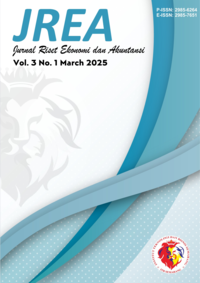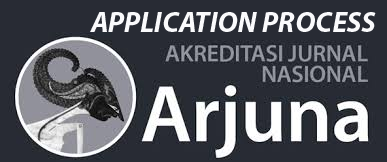Pengaruh Free Float Terhadap Likuiditas Saham Pada Perusahaan LQ45 Yang Terdaftar Bursa Efek Indonesia Tahun 2019-2023
DOI:
https://doi.org/10.54066/jrea-itb.v3i1.3019Keywords:
Free Float, Return on Asset, Return on Equity, Earning per share and Stock LiquidityAbstract
This study aims to determine the effect of the independent variables free float (FF) or shares circulating in the public and the control variables Return on Asset (ROA), Return on Equity (ROE) and Earning per Share (EPS) on the dependent variable, namely Stock Liquidity (TVA) which is measured by the level of stock trading volume in LQ45 Companies listed on the Indonesia Stock Exchange (IDX) in 2019-2023. This study is a study using a quantitative approach and the type of data used is secondary data sourced from the annual financial reports of LQ45 companies on the Indonesia Stock Exchange with an observation period of five years (2019-2023). The population in this study were 45 companies included in the LQ45 company and there were only 8 companies that were the research samples. This study uses panel data, namely a combination of time series and cross-section data using data analysis technique multiple linear analysis. Based on the results of the study and data analysis, it shows that partially the free float variable has a significant effect on stock liquidity, while the control variable return on assets (ROA) does not have a significant effect, return on equity (ROE) has a significant effect and earnings per share (EPS) has a significant effect on stock liquidity. Simultaneously, the free float variable, return on assets (ROA), return on equity (ROE) and earnings per share (EPS) together affect stock liquidity. The result of the determinant coefficient is 0.279, meaning that 27.9% of the stock liquidity variable can be explained by the free float variable, return on assets (ROA), return on equity (ROE) and earnings per share (EPS). The remaining 72.1% is explained by factors outside this research model.
Downloads
References
Afrianti, A., & Sarboini, S. (2020). Pengaruh kinerja perusahaan terhadap likuiditas saham menggunakan trading turnover pada Garuda Indonesia. JEMSI (Jurnal Ekonomi, Manajemen, Dan Akuntansi), 6(1), 1–11. https://doi.org/10.35870/jemsi.v6i1.333
Aisyah, P., Wulandari, F., & Ashfath, F. (2022). Pengaruh perubahan metodologi indeks saham menggunakan perhitungan free float terhadap kinerja indeks LQ45.
Arifin, A. (2007). Membaca saham. Andi Offset.
Çalişkan, M. T., & Keresteci̇oğlu, S. (2013). Effects of free float ratios on stock prices: An application on ISE. Doğuş Üniversitesi Dergisi, 14(2), 165–174.
Claessens, S., Djankov, S., Fan, J. P. H., & Lang, L. H. P. (2002). Disentangling the incentive and entrenchment effects of large shareholdings. Journal of Finance, 57(6), 2741–2771. https://doi.org/10.1111/1540-6261.00511
Darmawan Putra, D. R. A. (2018). Analisis pengaruh kepemilikan institusional dan kepemilikan manajerial terhadap kinerja dan nilai perusahaan. Studi Akuntansi dan Keuangan Indonesia, 1(1), 1–24. https://doi.org/10.21632/saki.1.1.1-24
Dwi, C., & Susilawati, K. (2012). Analisis perbandingan pengaruh likuiditas, solvabilitas, dan profitabilitas terhadap harga saham pada perusahaan LQ 45. 4(2), 165–174.
Fama, E. F., & Jensen, M. C. (2005). Agency problems and residual claims. SSRN Electronic Journal, XXVI(June 1983). https://doi.org/10.2139/ssrn.94032
Fitriani, D., Iqbal, S., & Andayani, W. (2020). Efektifitas free float dalam mendongkrak likuiditas Bursa Efek Indonesia. Mix Jurnal Ilmiah Manajemen, 10(1), 127. https://doi.org/10.22441/mix.2020.v10i1.009
Ghozali, I. (2011). Ghozali_Imam_2011_Aplikasi_Analisis_Mult.pdf (p. 129).
Gilson, R. J., & Gordon, J. N. (2003). Controlling controlling shareholders. University of Pennsylvania Law Review, 152(2), 785–844. https://doi.org/10.2307/3313035
Ismailsyah. (2020). Analisis pengaruh free float saham-saham first liner, second liner, dan third liner terhadap likuiditas saham.
Jensen, M. C., & Meckling, W. H. (1976). Also published in Foundations of Organizational Strategy. Journal of Financial Economics, 4, 305–360. http://ssrn.com/abstract=94043
Kasmir. (n.d.). Analisa laporan keuangan.
La Porta, R., Lopez-de-Silanes, F., & Shleifer, A. (1999). Corporate ownership around the world. Journal of Finance, 54(2), 471–517. https://doi.org/10.1111/0022-1082.00115
Laporan Keuangan Bank Central Asia Tbk. (2022). Laporan keuangan audit 2022. 2009.
Laporan Keuangan Bank Mandiri (Persero) Tbk. (2020). Laporan keuangan konsolidasian tahun 2020.
Laporan Keuangan Tahunan (2011). PT Bank Permata Tbk dan entitas anak / and subsidiaries. December.
Laporan Keuangan Tahunan (2020). Laporan keuangan PT XL Axiata 2020. December. https://www.idx.co.id/id
Laporan Keuangan Tahunan (2020). PT Astra Internasional Tbk 2022.pdf.
Laporan Keuangan Tahunan (2020). PT Bank Rakyat Indonesia (Persero) Tbk dan entitas anaknya. Laporan Keuangan Konsolidasian PT Bank Rakyat Indonesia (Persero) Tbk dan Entitas Anak Tanggal 31 Desember 2020, 6. www.idx.co.id
Laporan Keuangan Tahunan (n.d.). PT Unilever Indonesia Tbk Laporan Keuangan Tahunan 31 Desember 2022.
Laporan Keuangan Tahunan Aneka Tambang Tbk. (2020). Laporan keuangan tahunan. Bursa Efek Indonesia, 21(1), 1–9.
Lim, S. A. N., & Herawaty, V. (2020). Analisis pengaruh profitabilitas, likuiditas, dan manajemen laba terhadap kinerja pasar dengan volume perdagangan sebagai pemoderasi. KOCENIN Serial Konferens, 1(1), 1–11.
Meliana Nofia Wulandari, D. A. (2023). Pengaruh pengumuman laba dan return on asset terhadap volume perdagangan saham pada perusahaan manufaktur. 20(November), 11–21.
Mutira, P. (2019). Adakah pengaruh free float terhadap pelaku pasar saham di Indonesia? 21(1), 39–46.
Natsir, K., Bangun, N., & Waani, A. M. (2023). Analisis faktor-faktor yang mempengaruhi likuiditas pasar saham. 28(02), 155–176.
Nurhaeda, A. (2019). Pengaruh free float terhadap likuiditas saham pada perusahaan-perusahaan yang tercatat di Bursa Efek Indonesia. Tangible Journal, 4(2), 231–244. https://doi.org/10.47221/tangible.v4i2.81
OJK. (2023). Buku saku pasar modal ©Departemen Pengaturan dan Pengembangan Pasar Modal Direktorat Analisis Informasi Pasar Modal Tidak untuk diperjualbelikan. Ojk.Go.Id, 1–294.https://www.ojk.go.id/id/berita-dan-kegiatan/info-terkini/Documents/Pages/Buku-Saku-Pasar-Modal/BUKU%20SAKU%20PSR%20MODAL%20OJK%202023.pdf
Otok, B. W., Guritno, S., & Subanar. (2006). Faktor-faktor yang mempengaruhi volume perdagangan saham. Jurnal Widya Manajemen & Akuntansi, 6(3), 303–316.
Panda, B., & Leepsa, N. M. (2017). Agency theory: Review of theory and evidence on problems and perspectives. Indian Journal of Corporate Governance, 10(1), 74–95. https://doi.org/10.1177/0974686217701467
Polakitan, C. D. (2015). Analisis komparasi resiko saham yang terdaftar pada index LQ-45 dan non LQ-45. Jurnal Riset Bisnis dan Manajemen, 3(1), 61–72.
Setiyanto, A. (2006). Analisis likuiditas saham sebelum dan sesudah stock split. Syntax Literate; Jurnal Ilmiah Indonesia. https://doi.org/10.36418/syntax-literate.v7i9.14627
Shleifer, A. R. W., & Vishny. (1996). A survey of corporate licensing. In Idea (Vol. 24, pp. 59–92). 1997.
Suryo, A., & Tjahjono, A. (2021). Analisis faktor-faktor fundamental yang berpengaruh terhadap likuiditas saham pada perusahaan perbankan yang berada pada indeks Infobank 15 di Bursa Efek Indonesia periode 2015-2018. 1(2), 418–438.
Wachowicz, H. (2002). Financial management financial management. In Nursing Standard (Vol. 16, Issue 43).
Downloads
Published
How to Cite
Issue
Section
License
Copyright (c) 2024 Jurnal Riset Ekonomi dan Akuntansi

This work is licensed under a Creative Commons Attribution-ShareAlike 4.0 International License.







